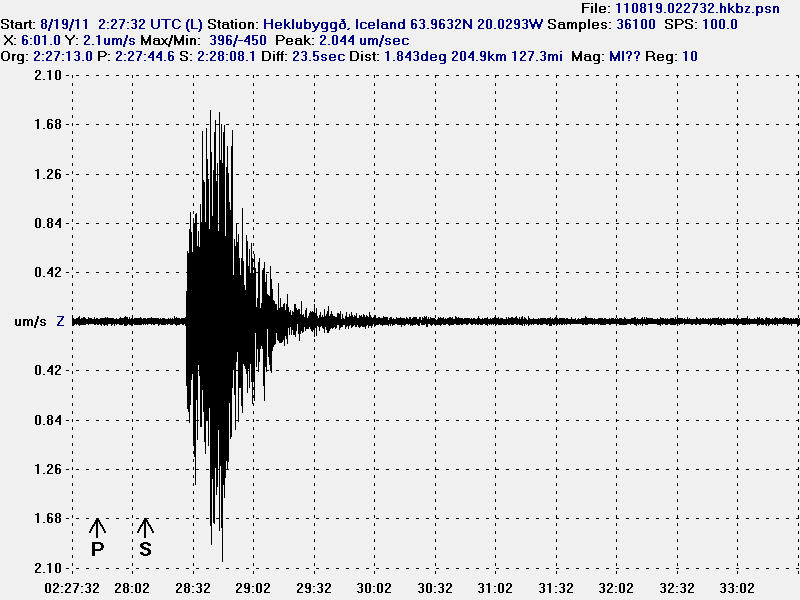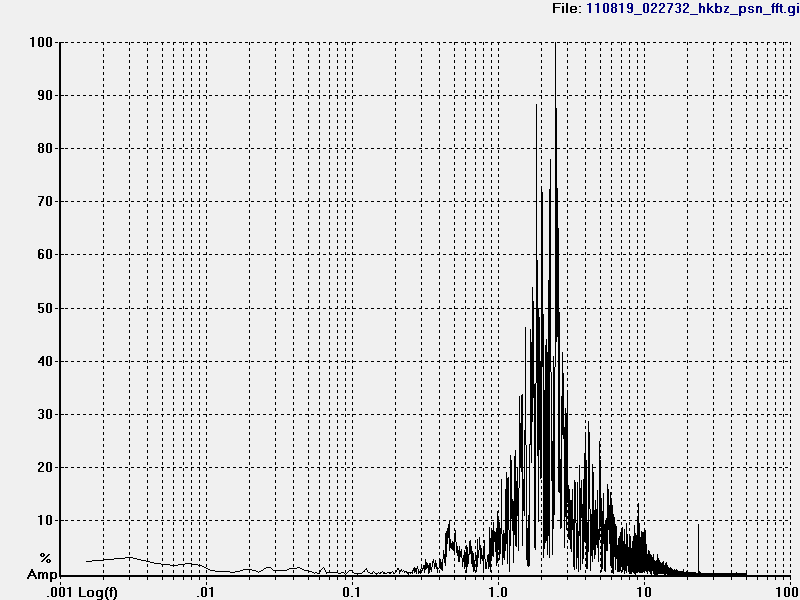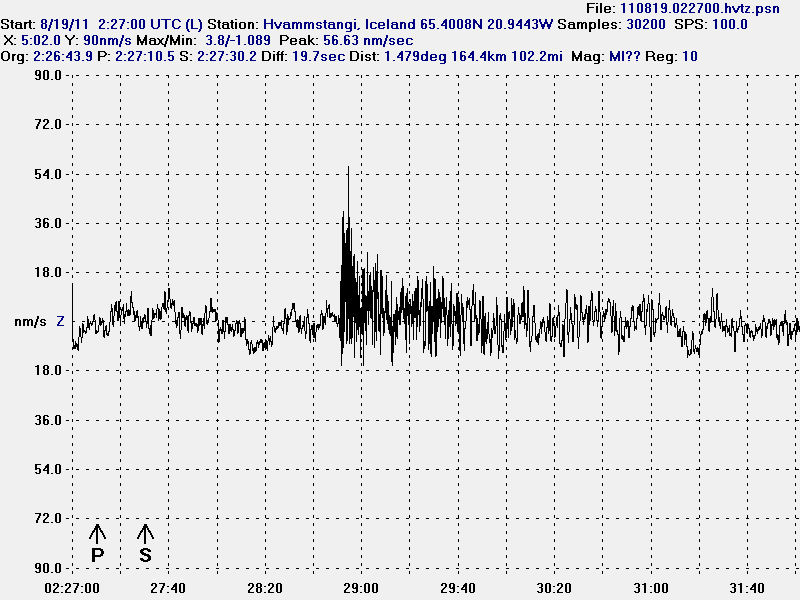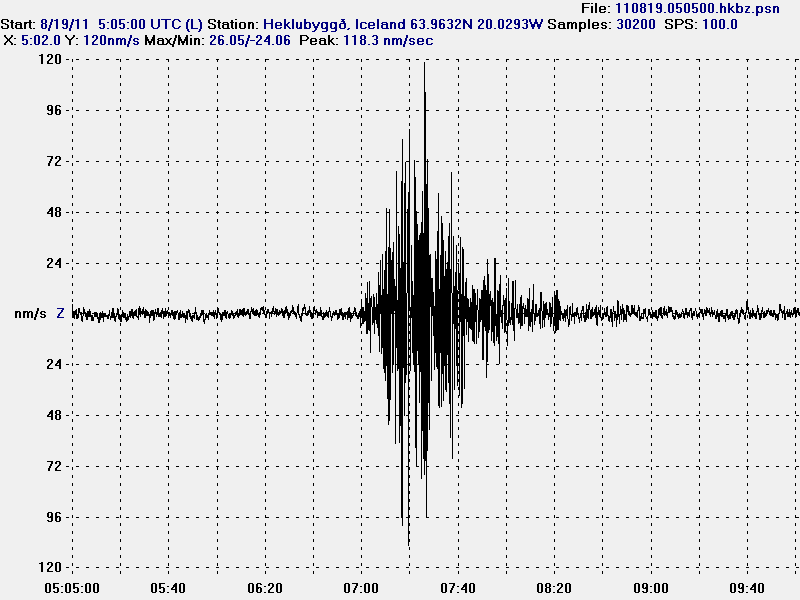Last night there was a earthquake with the size ML2.3 and with the depth of 1.3 km inside the caldera of Katla volcano. This earthquake might well be just part of the normal summer and autumn earthquake activity in Katla volcano. But at the moment it is hard to know for sure the difference at the moment.

Current area of activity in Katla volcano. It is mostly inside the caldera. Copyright of this picture belongs to Icelandic Met Office.

The ML2.3 earthquake in Katla volcano caldera last night. The P and S wave markers are unset. Picture Licence is Creative Commons.

The frequency spectrum of the Katla volcano caldera earthquake. As can be seen this earthquake has a lot of low frequency in it. Picture Licence is Creative Commons.

The Katla volcano caldera earthquake as it was recorded on my Hvammstangi geophone. It is quite unusual to record this small earthquake at this distance. This is filtered at 1Hz. Picture Licence is Creative Commons.

This earthquake here is from Goðabunga this morning. But Goðabunga is part of Katla volcano. But it is yet unknown if it is a volcano system on its own or not. The earthquakes from Goðabunga are different then the earthquakes from Katla volcano caldera, as can clearly been seen on this pictures. Picture Licence is Creative Commons.
Besides this minor earthquake activity. Everything remains quiet in Katla volcano at the moment. When that is going to change is impossible to know.
Blog post updated at 21:10 UTC.

Found this paper with some interesting plots that support your wave idea here:- http://hraun.vedur.is/ja/skyrslur/bls107-119.pdf
What was particularly intesting to me, was that there is some visual evidence of this wave pattern heading towards Krusivik from the west too?
It is not so odd that there is a visual pattern there, it is after all where the MAR hits Iceland. And as far as I know the MAR is feading energy into the system through the rifting process. So there is no surprise there.
Nice paper.
Boston Volcano Heads – Wow! Thanks for that – as its a new page thought I would repost so it isnt missed
http://i52.tinypic.com/i4hgew.gif
Glad you like it. Posting one also with Lurking’s cumulative intensity added.
This is getting good now, I love ground breaking thinking.
Lurking those little “tinypics” you post have big thought impact.
CLS I may have to read a few times what you say, but wow, I like what I hear.
Most interesting thread on the Internet at the moment.
I have tried to join word press, still have not received e-mail with my password, more captchas……..
16 years of earthquakes between Hengill and Hekla Volcanoes in South Iceland taken from Lurking’s data plot and shown on GoogleEarth, along with Lurking’s cumulative intensity plot and with a longitudinal elevation profile … all scaled on horizontal. longitudinal axis to correspond to oneanother.
Full:
http://twitpic.com/69fqex/full
Small:
http://twitpic.com/69fqex
Major source links:
Lurking EQ Data Plot: http://icelandgeology.net/?p=1329&cpage=1#comment-16405
Lurking Cumulative Intensity Plot: http://icelandgeology.net/?p=1329&cpage=1#comment-16531
I was looking at a map and discovered that Iceland has what I would call a twin sister!
Can anyone guess what her name is and where she is located?
Actually it is very fascinating, since it gives a great perspective on Iceland’s birth and magmatic processes, as I see it.
For the moment, I’ll leave it as a guessing game who her twin sister is, but will post the answer later.
New Zealand?
Thought at first Galapagos, but then that is on a triple junction – subduction zone plus hot spot; how about the Inner Hebrides in Scotland (and N Ireland) – massive basalt flows etc but no hyaloclastites
May be Ellesmere Island on the Alpha Ridge, because the Iceland Hotspot is supposed to have been beneath that island approximatly 90 million ago. Old volcaoes, fjords, arctic region, resembles Iceland. But then it would be more like an older sister than a twin, because of the age.
The Afar Depression in East Africa
Wow good anzwers, but not the one that caught my eye when I looked at this map …
http://i54.tinypic.com/a1pt1c.gif
I like the thought of the African rift, because if an island and hot spot develop there near the basalt floods, then in some millions of years from now, that will look similar to Iceland too. But ….
My candidate for Iceland’s twin sister is Tristan, because of all the commonalities seen on the map.
I also posted about it below as new post.
Azores is also very much alike Iceland. Although most of its eruptions are sub.aquatic and not subarial.
There is a bunch of eqs at Hengill and from there to Torfajökull in a row …
Yeah, I wonder what’s up with that.
Firstly Thank you for your hard work in producing another piece for the Iceland Volcanic Jigsaw Puzzle. Lot’s to think about there.
Secondly, my guess for Iceland’s sister would be Jan Mayen Island. It has a Hot Spot and is at the Northern end of the MAR with the associated rift formations. It actually forms a micro continent as it is located between tectonic plates. One being ancient and incative. It has it’s very own named fracture zone too. I would call her Iceland’s little sister as she is a lot younger.
Azores?
Sorry Renato Rio you asked first.
There has just been a shallow small quake on Öraefajökul, is that the first this summer?
Is the twin of Iceland the Azores?
All questions today, “giggle”
As far as i’ve seen it, those are the first two quakes in this area since more than two years.
i might be wrong, but it surely is not a common thing
i remember a few last year
Another quake at Öraefajökul, deeper and larger 8km provisional.
This is unusual…
I just noticed these quakes in Öraefajökul, it’s certainly interesting activity. I’ll post the details anyway:
Sunday
21.08.2011 12:41:10 64.021 -16.699 8.1 km 2.1 53.17 1.0 km NW of Hvannadalshnjúkur
Sunday
21.08.2011 12:14:36 64.025 -16.621 0.1 km 1.3 90.01 3.2 km ENE of Hvannadalshnjúkur
the quakes have been revised and are now both at about 10km depth.
21.08.2011 12:41:10 63.997 -16.640 10.1 km 1.3 99.0 2.9 km SE of Hvannadalshnjúkur
21.08.2011 12:14:37 64.000 -16.623 10.8 km 1.6 99.0 3.4 km ESE of Hvannadalshnjúkur
Etna?
Look at the earthquake belt south, on the map at IMO.. That has to count for something, right?
A twin sister of Iceland?
When looking at the following, two locations stand out as different from all the others and similar to one another …
http://i54.tinypic.com/a1pt1c.gif
Tristan and Iceland. Both born at the mid-Atlantic ridge when it first started opening, both dumped a lot of lava out in flood basalt provences, both located at stationary hot spots, both very active volcanic areas. Early on, Tristan wandered of a ways from being directly over the mid-Atlantic ridge and perhaps that was the reason it didn’t grow in size compared to Iceland. I never knew about Tristan, until looking at the above link and seeing the similarities to Iceland.
BVH, no doubt possible, you must have found Iceland’s little sister! How nice to learn about such a beauty.
Here is a site with some information and pictures that might as well have been taken on Iceland (at least, so it seems to somebody who unfortunately not was there yet), only except for the palm trees maybe.
Thank you very much for telling us about it!
http://www.imagegossips.com/2010/12/most-isolated-island-in-the-world/
I ranked again the largest eruptions in Iceland, in Holocene, and bigger than 1 cu km of lava or tephra (VEI5 lower limit). Have fun reading below!
Ash-wise, the largest eruptions in Iceland were the eruption of Grimsvotn around 8300 BC (I did not know about this), the Oraefajokull eruption in 1362, the Bardarbunga eruption in 1477 (VEI6) and the Hekla eruption in 1100 BC, all were about 10 times stronger than a strong Katla eruption, and 20 times more than the Grimsvotn eruption in 2011!!
Also strong tephra eruptions were the ones from Katla in 934, Bardarbunga in 870, Hekla in 1104 and Askja in 1875 (VEI5). Following these, are many Katla eruptions (like 1755 or 1918), which are about twice the size of last Grimsvotn eruption.
Rank by tephra: (settlement eruptions are numbered)
– 8330 BC Grimsvotn (Saksunarvatn) 15 cu km
1- 1362 Oraefajokull 2.3 to 10 cu km (estimates varied)
2- 1477 Bardarbunga/Veidivotn 10 cu km (+ 3 cu km lava)
– 1100 BC Hekla 7.3 cu km, perhaps more, since it cause a volcanic winter
– 2310 BC Hekla 6 cu km
3- 934 Eldgjá/Katla 5 cu km (+ 18 cu km lava)
4- 870 Bardarbunga (Vatnaoldur) 4.5 cu km
5- 1104 Hekla 2.5 cu km (estimates varied)
– 5150 BC Hekla 1.8 cu km
6- 1875 Askja 1.8 cu km
7- 1755 Katla 1.5 cu km
8- 1262 Katla 1.5 cu km
9- 1625 Katla 1.2 cu km
10- 1721 Katla 1.2 cu km
11- 1783 Laki/Grimsvotn 0.9 cu km (+15 cu km lava)
12- 1918 Katla 0.7 cu km
13- 1357 Katla 0.7 cu km
14- 1963 Surtsey 0.7 cu km
15- 2011 Grimsvotn 0.66 cu km !!!!!!
(… several Katla eruptions)
…- 1766 Hekla 0.3 cu km (+ 1.3 cu km lava)
…- 2010 Eyjafjallajokull 0.25 cu km
…- 1947 Hekla 0.2 cu km (+ 0.8 cu km lava)
…- 1727 Oraefajokull 0.1 cu km
Lava-wise, Bardarbunga spilled the largest lava eruption in Holocene (and in the world), followed by Theistareykjabunga, both well larger than Laki!! But these were pre-settlement eruptions. Eldgjá ranks third close to these, and Laki fourth. Another very large settlement lava eruption occurred in 950 from Hveravellir (on the same scale). Also impressive are pre-settlement eruptions of Hengill, Prestahnukur and Brennisteinsfjöll, all of them close to the Laki scale.
If we scale these down 20 to 50 times, then we have most of recent lava eruptions of Hekla (including 1947), Krafla (including the Myvatn fires), Askja, the eruptions in the Westman Islands, etc. So small amounts of lava were on these!
Rank by lava: (settlement eruptions are numbered)
– 6650 BC Bardarbunga/Veidivotn (Þjórsárhraun) 25 cu km lava
– 9500 BC Theistareykjabunga 18 cu km lava
1- 934 Eldgjá/Katla 18 cu km lava (+ 5 cu km ash)
2- 1783 Laki/Grimsvotn 15 cu km lava
– 5000 BC Bardarbunga 15 cu km lava
– 8250 BC Hengill/Thingsvellir 11 cu km lava
– 7550 BC Prestahnukur 11 cu km lava
– 5850 BC Hveravellir 11 cu km lava
– 9000 BC Brennisteinsfjöll 10 cu km lava
3- 950 Hveravellir 9 cu km lava
– 7100 BC Bardarbunga 8 cu km lava
– 2050 BC Hveravellir 7.3 cu km lava
– 5000 BC Kverfjoll 7 cu km lava
– 1950 BC Grimsvotn 6.9 cu km lava
– 1200 BC Bardarbunga/Veidivotn 6.5 cu km lava
– 8600 BC Hveravellir 6.3 cu km lava
– 8900 BC Askja 6 cu km lava
– 3250 BC Hengill 6 cu km lava
– 4000 BC Reykjanes 5.7 cu km lava
– 5550 BC Katla/Holmsá fires 5 cu km
– 5000 BC Reykjanes 5 cu km lava
– 8500 BC Krisuvik 4.5 cu km lava
– 8200 BC Hengill 4 cu km lava
– 4600 BC Bardarbunga 3.8 cu km lava
– 6000 BC Krisuvik 3.5 cu km lava
– 4200 BC Bardarbunga/ Veidivotn 3.4 cu km lava
– 1250 BC Krafla 3.3 cu km lava
4- 1477 Bardarbunga/Veidivotn 3 cu km lava (+ 10 cu km ash)
– 2660 BC Brennisteinsfjöll 3 cu km lava
– 300 BC Krafla 2.5 cu km lava
– 5000 BC Hengill 1.6 cu km lava
5- 1766 Hekla 1.3 cu km lava
– 4270 BC Grimsnes 1.2 cu km lava
– 1730 BC Hengill 1 cu km lava
– 7050 BC Ljósufjöll/Eldborg 1 cu km lava
(…)
6- 1947 Hekla 0.8 cu km lava
7- 1996 Grimsvotn 0.7 cu km lava
8- 1240 Reykjanes 0.7 cu km lava
9- 1325 Krisuvik 0.5 cu km lava
10- 950 Brennisteinsfjöll 0.5 cu km lava
11- 1728 Krafla 0.4 cu km lava
12- 1875 Askja 0,3 cu km lava
13- 1963 Surtsey 0.3 cu km lava
14- 1924 Askja 0.3 cu km lava
15- Heymaey 0.2 cu km lava
16- 2000 Hekla 0.2 cu km lava
17- 1984 Krafla 0.1 cu km lava
18- 1961 Askja 0,1 cu km lava
Another Irpsit cracker! Is anything known about the magma type for these or are all basalt -alkali/tholeitic rather than more acidic types?
Very extinct volcanism question – are there any known vents/eruptive centres for the massive flows seen in the western fjordlands? Or was Snaefell the centre?
The acid/basalt question, I cannot answer. Maybe someone knows about it.
West fjords, volcanism is extinct long ago. The mountains there have been long under erosion. I don’t know which ones were the central volcanoes, but I read about that information for the East Fjords a while ago. Again, maybe someone else can answer that.
Lurking: Could you make a time line plot of these (X-axis is time, Y-axis volume in cubic km, maybe logarithmic)?
http://i54.tinypic.com/2enn3x0.png
And using the linear trend as the average, calculated sigma.
http://i51.tinypic.com/2zjgtas.png
My interpretation is that it could be a 500 years before a large effusive event occurs, and that would still be within the 2sd trend line.
If I remember I came up with a cut-off value of 473 when I calculated all events with a combined ejecta of 10 km3.
You know what disturbs me with the image, there is nothing that could be counted as a “hundred year perfect storm” in it. And that disturbs me. Because if one looks at Iceland there are features that are on a different scale than what has happened after the iceage.
I am not in any way trying to be alarmist, but the age of Iceland does not really add up with the amount ejecta per thousand year in the plot and Icelands physical size.
And before anyone asks, no I do not know of any such large-scale eruption before or during the iceage. It might be that eruptions just where a lot more common before and that we are just in a lull in the icelandic volcanism. Just pure speculation on my part here.
Well, though there is a lot of material that makes up Iceland, do keep in mind that some of it’s areal extent was below sea level not too long ago. Hello lithospheric rebound.
I wonder if the crust tends to overshoot the equilibrium point when that happens, and go into a rather long period oscillation until it stabilizes. (thousands of years)
Hreppar micro-plate also brings in a lot of problems. As it does things its own way. What effects it has on nearby fracture zones and volcanoes is unknown from what I can tell at the moment.
Yuo have three problems here:
First, each ice age tends to wipe out “proving items”, i.e. ice masses cause heavy erosion.
Second, Iceland is older than the current era of ice ages. The current era started about 2-3 million years ago (see http://en.wikipedia.org/wiki/Ice_age#Major_ice_ages ).
Third, the trails of the more recent eruptions tend to hide older eruptions trails.
All in all, there’s much more in the geological history of Iceland, but it is quite difficult to find intact evidences on it.
It seems to me that if, from the least dense (vacuum of space) to at least very dense (metals), waves have their own ways of traveling through them. They manifest themselves in thier own unique way from ocean waves to vibrations to the invisible. It makes perfect sense to me that magma and the crust would have thier own unique manifestation of waves.
I would though warn against making wave-interpretations of everything. There is many other ways power and other things can travel. In the most basic sense of it volcanos are governed by fluid dynamics and gas-dissolution principles.
Please remember that this is a special case. At least I think so. On the other hand Wave-dynamics is a part of fluid dynamics… Ahem, well. One should always be ware of over-interpretation 😉
Ugghh… Another year older tomorrow… but my age has nothing on the volcanoes! 😉
I am not a Physicist but I am trying to think this through. Trying to think of examples of ways energy is transfered that without waves. Biological is the obvious answer to me. Maybe heat but I am not sure about that except when it manifests itself as light. Do you have more examples?
I will recomend the best book about physics ever written, Brian Greenes “A beautifull universe”. Fantastic book that in as easy a way as possible explains modern physics.
If you feel a bit more experimentall and really want to understand how I am thinking I recomend my teachers teachers book, QED by Richard Feynman. It is actually quite readable, and still it explains the hardest part of physics.
Remember, what you see as a wave is just a side effect of the energy travelling as a wave, the water is actually not moving per se (more than a little up and down). It is just a reflection of the wonder that is actually happening.
“What we perceive as reallity is just a glimmering reflection of the beautifull universe that hides just out of view. A physicist is someone who loves the beauty so much that he or she tries to peak behind the reflection to see more of the hidden beauty.”
(Quoting myself here…)
“Remember, what you see as a wave is just a side effect of the energy travelling as a wave”
That is exatly my point. Although chaotic, magma should be expected to see those same side effects from the energy stored within it.
Yes, a any fluid can have waves travelling through them. For instance can an explosion cause a concussive wave-front to travell through the fluid.
But the actual movement of the fluid (magma for instance) is goverend by fluid dynamics, not wave dynamics, although they are related like cousins in the field of physics.
Some ways energy is tranferred without waves: by thermal conductivity (lava cooling), by kinetic motion (eg cannon ball, lava bombs), by chemical reaction (dynamite, food digestion).
In the final anlysis, by the laws of thermodynamics and conservation laws, all energy and energetic processes will degrade to useless thermal radiation as time goes on, resulting in a cold, dark universe: without stars, without quakes or volcanic activity and without any possibility of life of any sort. :O
Don’t blame me. I didn’t design the damn thing.
🙂
Thanks for the help in understanding. I think I understand that Magma would be governed by fluid dynamics because it is under pressure. Like hydraulics. I still wonder if the high energy stored in the magma might change that but I have no way of knowing that. I dont know if anyone will read this but I really dont want to get in the way of the next thread.
Electricity would be hard to describe as a wave i guess.
Electricity is a movement of electrons. An electron is a physical entity with a rest mass of about 9.10938215 × 10^−31 kg.
But… an electron also has a wavelength… depending on the environment. 12.3 picometers or 2.5 picometers has been calculated.
And… electrons vibrate. This vibration can move energy also, but in the form of photons. I can be stated that a photon’s movement is nothing more than a transfer of this vibratory energy through a sea of electrons (on their respective atoms)… but what about the vacuum of empty space? Well, photons are also physical entities, and have a finite size like a particle. (a wave packet)
Duality… got to love it. The ultimate brain torque.
As Carl stated; “One should always be ware of over-interpretation”
Just because phenomena _seem_ to be related, it doesn’t mean that they are.
I am nowhere near qualified to interpret but plenty qualified to question. Thanks for the explanation.
Heh… not a prob.
Wanna get even more detail bound?
Electricity comes in two forms (three really)
DC – Direct Current. Electrons move in one direction. “Point A to Point B”
AC – Alternating Current. Electrons move towards point B, but turn around and go back towards A.
Both forms transfer energy with electrons, though with AC they never actually get to the destination, but the energy does.
Also, with AC, energy is radiated away from the conducting medium (usually a wire of some sort) in the form of radio waves (RF)… also known as electromagnetic radiation. Being “electomagnetic” means that there is a combination of electric potential, as well as a magnetic potential. (at right angles to each other in polarization).
And… since we are dealing with electromagnetic energy… they can also be thought of a packets… or quanta. So, we are right back into the photons of light idea again.
Fun eh?
Oh yeah, that third form of electricity.
Static Electricity. No clear direction or purpose, just an accumulation of electrons for what ever reason… waiting for a place to go.
I get a little lost in the details, I am not fluent in electrician. When I thought more about heat, IR radiation came to mind so I am still left with biological.
Biological?
Think chemicals… with a little bit of electricity thrown in for good measure.
Let’s not mention the nasty lil secrets about the electron which physicists are uncomfortable with explaining. Like the fact that it has zero size and infinity density is something which might confuse some people. lol And that a single electron fired at two side-by-side slits will go through both slits at the exact same time … but only if no one is watching it … if someone watches to see this happen, it will only go through one slit, but never both … and that is a real law of physics.
In the final analysis, no one really understands electrons.
“What I am going to tell you about is what we teach our physics students in the third or fourth year of graduate school… It is my task to convince you not to turn away because you don’t understand it. You see my physics students don’t understand it… That is because I don’t understand it. Nobody does.”
— Richard P. Feynman (QED: The Strange Theory of Light and Matter)
Just don’t try to figure out quantum entities in classical terms, it gives you only a good headache…
Electrons have no size (in classical terms). However, that does not mean they are indinitesimally small (a classical term, again). But experimenters state, that if electron had a classically understood size, it would be less than 10^-22 m (see http://en.wikipedia.org/wiki/Electron#Fundamental_properties ).
Readeth QED and the light will come to you.
Actually it is a quantum electric waveform that moves the energy, not the electrons per se. But, it is a one hell of a lot of easier way to calculate that Lurking gave down there.
If one ever wants to enter the Wavy side of life that is the Book to Read 😉
Speaking of “ease of calculation,” I come from the school of “electron flow.” It’s a technicians view of electricity and focuses on current flow.
Engineers tend to be versed in and think in “hole flow” which is a way of saying voltage flow.
I had one piece of gear that was taught in voltage flow and had one hell of a time trying to figure out what the course was trying to teach. After tracing a signal through the schematic and noticing that all the diodes were pointing in the direction of the signal path I realized what they were doing. (current flows against the arrow) After that it finally made sense.
I know, one of lifes nuttier mysteries, that we still write electrical symbolism arse backwards… Sigh…
New blog post is up! 🙂